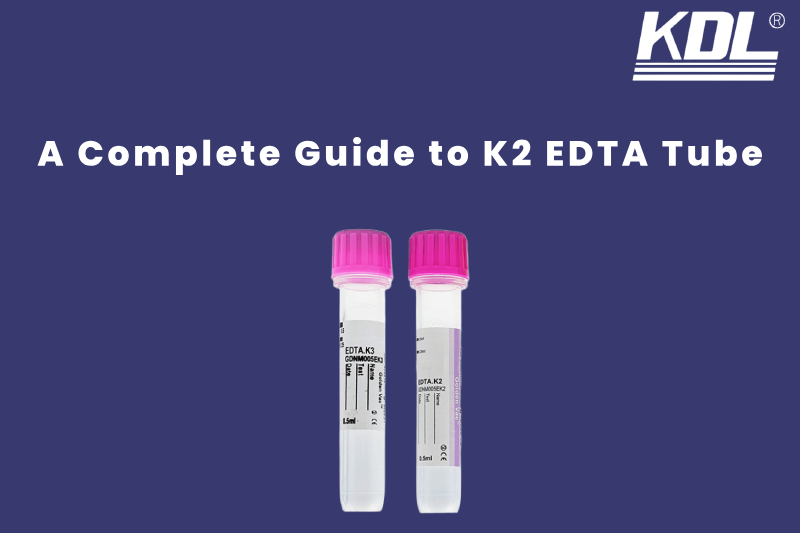
If you’re new to the world of clinical diagnostics or laboratory medicine, you’ve probably come across the term K2 EDTA tube. These tubes play a vital role in modern blood collection and testing. In this beginner’s guide, we’ll explore what K2 EDTA tubes are, uses, benefits, and how to choose the right one for your needs.
What is a K2 EDTA Tube?
A K2 EDTA tube is a type of blood collection tube that has dipotassium ethylenediaminetetraacetic acid in it to help prevent blood from clotting. EDTA helps keep blood from clotting by grabbing onto calcium, which is essential for the clotting process. You end up with a whole blood sample that’s preserved and ready for testing different cellular components.
K2 EDTA is different from K3 EDTA when it comes to its chemical makeup. So, both of them do the same thing, but K2 EDTA has two potassium ions, and K3 EDTA has three. Pretty straightforward, right? You know, this difference in concentration can have a bit of an impact on how the cells look under the microscope. That’s why K2 EDTA is usually the go-to choice for hematology tests—it’s easier on the cells.
Also Read : What Are EDTA Tubes?
Types of K2 EDTA Tubes
K2 EDTA tubes are available in different formats, each design to meet specific clinical and lab needs. Let’s break down the main categories that help us tell them apart:
1. Volume and Size
Pediatric Tubes: These little tubes, usually 2 ml or less, are made to gather just a tiny bit of blood, perfect for infants and kids.
Standard Tubes: It come in sizes from 3 ml to 5 ml and are typically used for adult patients during routine blood tests.
2. Tube Material
Plastic tubes: It is safe for everyday use because they are light and don’t break easily. They are use a lot in modern labs.
Glass tubes: It is not use as much these days, but they are still use in some places because they are harmless. In some research situations, the fact that glass doesn’t react with samples or chemicals can be helpful.
3. EDTA Additive Form
Spray-Dried EDTA: It spray the EDTA onto the inside surface of the tube, making sure it gets an even coating. This kind really helps make sure the samples are consistent.
Liquid EDTA: It is an anticoagulant that comes in liquid form and is added straight into the tube. You can use these tubes in situations where you need a certain concentration.
Each type has its own strengths, and the choice depends on the intended laboratory test and the required sample quality.
Common Uses of K2 EDTA Tubes
K2 EDTA tubes are used in many types of laboratory testing. Their primary role is to collect whole blood for analysis, but their utility goes beyond just routine testing.
- Hematology Testing: These tubes are standard for complete blood count (CBC), white blood cell differential, and red cell indices. EDTA maintains cellular integrity, which is essential for accurate results.
- Molecular Testing: These tubes are often use in DNA and RNA analysis because EDTA stabilizes nucleic acids, preventing degradation during storage or transport.
- Blood Banking Procedures: K2 EDTA is use in typing and crossmatching because it preserves red cell antigens, making them suitable for immunohematological studies.
It is important to note that K2 EDTA tubes should not be used for tests involving clotting factors or serum-based analyses, as the anticoagulant interferes with those results.
Benefits of Using K2 EDTA Tubes
K2 EDTA tube are use in many labs because they work well and give consistent results. Here are some key benefits:
1. Accurate Blood Cell Tests
EDTA keeps blood cells in their natural shape. This helps get more reliable results in tests like the complete blood count (CBC) and white blood cell checks.
2. Stable Samples
These tubes keep blood samples in good condition for longer. You don’t need to test them right away. This is helpful when samples are sent to another lab or tested later.
3. Less Risk of Hemolysis
EDTA helps stop red blood cells from breaking down. This protects the sample and helps make sure test results are correct. It works well for both manual and machine testing.
4. Works Well with Lab Machines
K2 EDTA tubes are made to work with automated lab machines. This helps labs work speedly and more smoothly.
Because of these benefits, K2 EDTA tubes are very useful in both small clinics and large testing labs.
Comparison with Other Blood Collection Tubes
To choose the right tube for a test, it’s important to understand how K2 EDTA tubes are different from other common types.
1. K2 EDTA vs K3 EDTA
Both tubes use EDTA to stop blood from clotting. But K2 EDTA is usually preferred because it has less effect on the size and shape of blood cells. This makes it better for detailed blood tests in hematology.
2. K2 EDTA vs Sodium Citrate Tubes
Sodium citrate tubes is use for coagulation tests, like PT and APTT. These tubes protect the blood’s clotting factors. EDTA tubes should not be used for these tests because they block clotting completely. Each type is used for different purposes.
3. K2 EDTA vs Heparin Tubes
Heparin tubes are use for plasma-based chemistry tests. But they don’t keep blood cells in good condition. K2 EDTA tubes are better when the test needs whole blood with healthy, intact cells.
4. K2 EDTA vs Serum Separator Tubes (SST)
SST tubes contain a gel that separates the liquid part (serum) from the blood cells after spinning in a centrifuge. It is use for biochemistry tests. But they are not good for tests that look at blood cells. For those, EDTA tubes are a better choice.
| Tube Type | Additive | Main Use | Top Color |
|---|---|---|---|
| K2 EDTA | Dipotassium EDTA | Hematology, DNA/RNA | Lavender |
| K3 EDTA | Tripotassium EDTA | Hematology | Lavender |
| Sodium Citrate | Citrate buffer | Coagulation studies | Light Blue |
| Heparin | Lithium/Sodium Heparin | Plasma chemistry | Green |
| SST | Clot activator + gel | Serum biochemistry | Gold/Yellow |
Choosing the Right K2 EDTA Tube
To get the best test results, it’s important to choose the right type of K2 EDTA tube. Here are the key things to consider:
1. Type of Test
- For regular blood tests like CBC, use tubes with spray-dried EDTA.
- For DNA or RNA testing, pick tubes that are very clean and have low contamination risk.
2. Age of the Patient
- Use pediatric tubes for babies and young children.
- These smaller tubes help avoid taking too much blood.
3. Tube Quality and Safety
- Choose tubes that meet international standards, like ISO or have a CE mark.
- These tubes are more reliable and approved for clinical use.
4. Tube Color and Labeling
- Lavender-colored caps show the tube contains EDTA.
- This helps lab staff avoid mistakes, especially in busy environments.
5. Storage Conditions
- Keep EDTA tubes at room temperature.
- Store them away from sunlight to keep the additives stable.
Conclusion
K2 EDTA tubes are a trusted and important tool in medical labs. They help keep blood cells and genetic material (like DNA) in good condition, which leads to more accurate test results.
Whether you’re working in a small clinic or a large laboratory, using the right K2 EDTA tube makes testing faster, more reliable, and more efficient.
If you’re planning to standardize your lab supplies, talk to a trusted K2 EDTA tubes manufacturer and supplier. They can help you choose the best K2 EDTA tubes for your testing needs.
 +86-791-8686-1216
+86-791-8686-1216 

